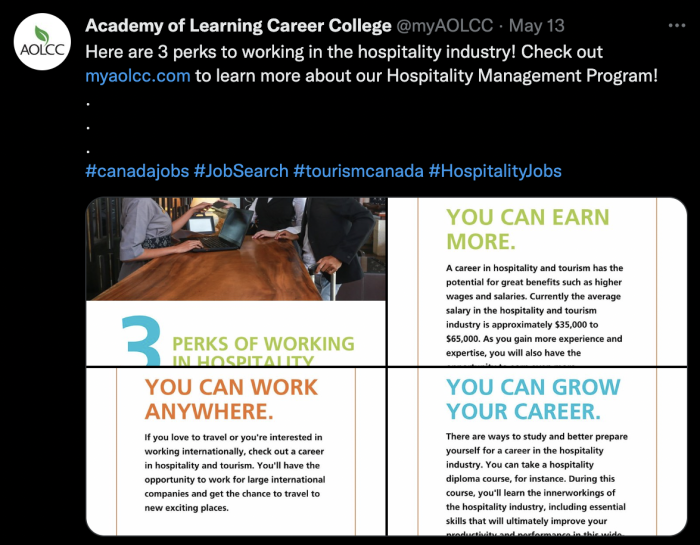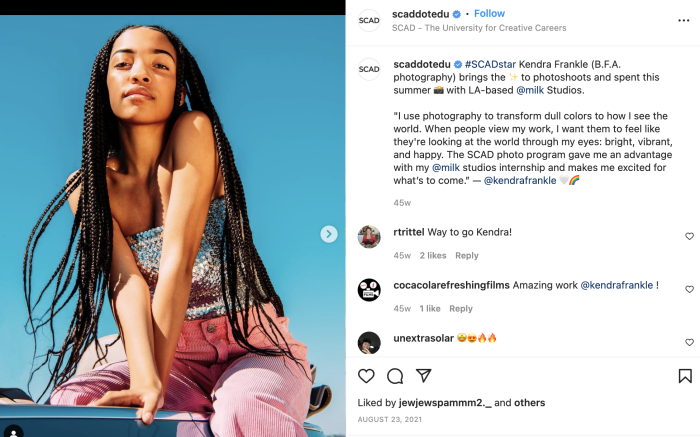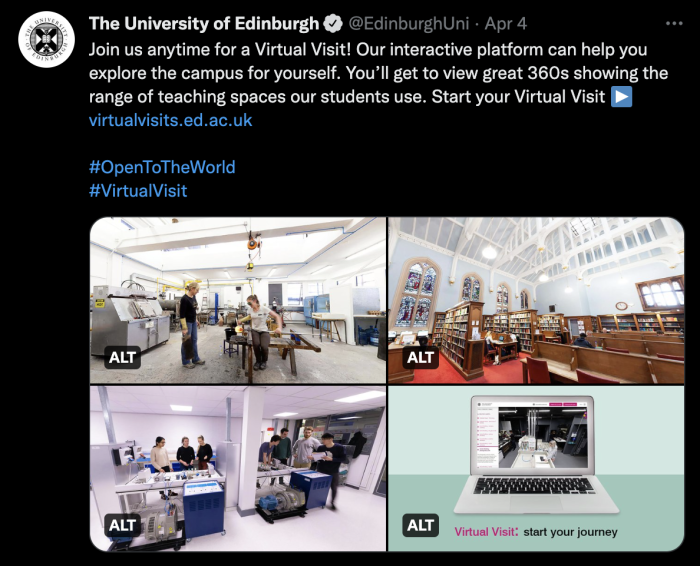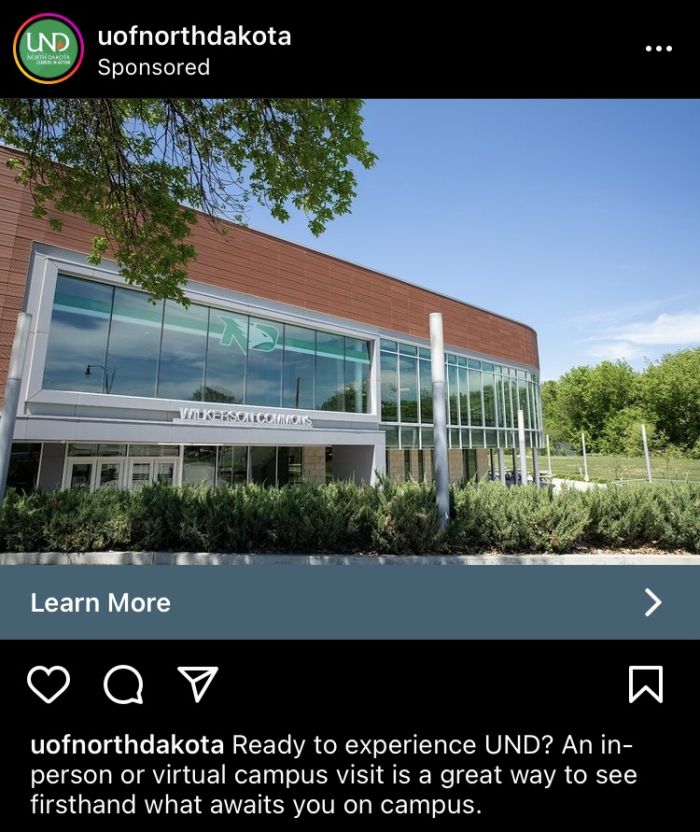As an extension of your school’s branding, social media in higher education is a great opportunity for you to open a new channel of communication with potential students. It is a chance to build your school’s online presence and connect with prospects in a more meaningful way.
However, that also means that any and all content you share on social media platforms should support your school’s digital marketing goals; you have to find ways to align your social media strategy with your school’s mission and values.
Without a social media plan and alignment to your organization’s goals, posts can end up just being noise on the web and accomplish little. Whether you’re looking to increase enrollment, drive website traffic, or distinguish your programs from other schools, here are some key ways that you can focus your social media strategy on your school’s goals.
Alignment With Your School’s Marketing Goals
Do you want to gain more followers? Increase the number of visits to your campus? Build your school’s academic reputation? Knowing the desired outcome gives you something to work toward as you implement your school’s social media strategy.
More importantly, these goals should be based on and reflect your school’s overarching goals. Defining your brand is the first step to ensuring that your social media goals are in line with the rest of your digital marketing efforts. Before sharing a post, think about the bigger picture. That includes your school’s target audience, its unique selling points and the current education landscape. Ask yourself what a prospective student wants to achieve and what your school can offer to help them get there. Keep that information in mind when designing school social media posts.
For example, the Academy of Learning Career College describes the benefits of working in the hospitality industry on its Twitter page. By piquing interest in this career path, the post supports the school’s wider goal to recruit students for its Hospitality Management Program.

Source: Twitter
By asking yourself what each post is trying to achieve, you can develop a more focused social media strategy with a relevant mission.
Find a Consistent Voice for Your School’s Channels
The tone of your social media platforms should be another key concern; you want your online voice to speak to your school’s mission and align with the overarching identity of your school. Your school’s social media presence is part of its brand, and the way it is presented should be consistent.
Once again, this involves looking back at the values and goals of your institution. If you’re a business school, perhaps your content should adopt a professional, academic tone. If you’re a college catering to career seekers, your content might centre around inspiring student success stories.
For example, Imperial College London prides itself on excellence in Science, Technology and Medicine. As such, the school’s social media channels regularly feature content on industry news and relevant research it performs. Posts like the one below support its identity as a leading scientific institution while attracting prospective students to the high calibre of education.

Source: Instagram
On the other end of the spectrum, The Savannah College of Art and Design (SCAD) has carved an identity as “The University for Creative Careers.” To reflect that, its social media posts are fun, colourful and visually appealing. First and foremost, the posts aim to showcase the artistic success of its students.

Source: Instagram
It’s important to remember that students will be looking to social media in higher education to get a better idea of their prospective schools. In that case, think about how you can bring the personality of your school and its community across.
Appeal to Prospects With Unique Platform Features in Your Social Media in Higher Education Efforts
While consistency is key, you also want to make your content as dynamic as possible. Social media in higher education is a chance for you to get creative with presentation, visuals, user engagement and online trends.
To make the most of your school’s social platforms, you should be tapping into all the tools and features that they offer. Many of these features are well suited to the kind of content that your school should be producing, and are a proven way to increase engagement with your brand.
For example, Instagram Live is a great option for Q&As from students or professors. Facebook Events are a convenient way to promote upcoming open days or other activities on your campus. Likewise, Twitter Polls can be used to engage with prospective students and get their input on the kind of content they want to see from your school.
For example, the University of Oxford created an Instagram Story to answer some user questions about the Engineering faculty.

Source: Instagram
Features like Instagram Reels and Highlights are a great way to give prospects the information they want in a convenient and engaging format. As HEM’s Senior Social Media Specialist, Natalia puts it “Use social media in higher education as a recruitment tool. Since a lot of prospective students visit the social media platforms of the school they are considering, it is important to have a couple of posts directed to them.”
TikTok is a particularly useful platform for sharing short-form videos that appeal to prospect interest, such as tours and student interviews. Think of these videos as a behind-the-scenes look at your school and its offerings. This is a great way to not just tell prospects what is unique about your school but to show them.
The example below shows a TikTok by the University of Leeds, which walks users through some of the best spots around the city.

Source: TikTok
Not to mention, TikTok is currently one of the fastest-growing social media platforms, with roughly 50% of its audience being under 34. If you want to compete on social media in higher education, you’ll definitely need to be active on TikTok, as your target audience is likely to be on this channel.
Coordinate Your Posts With Key Events
To keep your social media strategy aligned with your school’s recruitment goals, you should schedule your content in a way that makes the most impact on your target audience.
Application deadlines are one of the biggest factors to consider. If your target audience is high school graduates, think about when they will start researching schools for their future. During that time, your social media channels should feature important information that will help them learn more about your school and what it offers. Posts about financial aid, student support services, clubs and FAQs are all examples of things that can influence a prospect’s decision to apply to your school.
For example, Cambridge University shared some application tips on its Instagram page in the lead-up to the undergraduate deadline.

Source: Instagram
With these kinds of posts, prospective students get the resources they need to take practical steps towards enrollment. Another way to coordinate your social media efforts is to schedule content based on key happenings in and around your school. This may include holidays, milestones, annual events or campus tours. For example, The University of Alberta used social media to advertise its Open House. Along with creating a Facebook event, the school also posted a last-minute reminder the day before to maximize attendance.

Source: Facebook
Along with informative posts, potential students also want to see content that gives them a better idea of what life at your school is like. Social media is your chance to initiate those prospects into the school community by keeping them informed on what’s going on. The activities and events that you choose to highlight will ultimately depend upon the image that you’re trying to paint.
For example, you might highlight key sporting events on campus if that’s one of your school’s strong suits. Prospects interested in the athletic reputation of your school might be visiting your social media pages to see how you fare in key games. Duke University prides itself on its intercollegiate athletic teams, and regularly posts updates on its past victories and upcoming games.

Source: LinkedIn
These types of posts are a great way to encourage a sense of school spirit through social media and align your content with the unique experience on your campus.
Inspire Action With Social Media in Higher Education
The most effective social media posts should ultimately incite action in viewers. Perhaps you want prospects to register for your next open day? Or book a consultation with an admissions officer? Whatever the goal of your post, a landing page is where that action happens.
Landing pages should be easy for prospects to locate. What does that look like? A clear and engaging call to action. According to Natalia, your school should be aiming to include a relevant CTA with each social media post–one that leads users to a landing page on your website where they can take the next step in their enrollment journey.
Example: A Tweet from The University of Edinburgh invites users to explore its campus with the CTA “Start your Virtual Visit” and a link that takes you directly to the web page. The images also give users a teaser of what’s to come.

Source: Twitter
Ultimately your CTA will depend upon what your school is trying to achieve. If your goal is to get more students to sign up for a specific course, you can link the program page to your social media post with the CTA “Learn more here!”
Reach Your Goals With Paid Ads
With the right content down, it’s all about getting your posts seen on social media. Social media advertising is the easiest way to boost visibility for your school. Paid social ads are great for accomplishing goals such as generating new leads, increasing responses to events or encouraging a specific action.
To make the most of this tool, think about which platforms to advertise on and which content is worth boosting. Instagram’s ad reach has grown by over 60% in the last two years, making it a worthy investment for marketers. Much like Facebook, Instagram ads allow you to target audiences based on location, interests, demographics, behaviour and other factors.
Example: The University of North Dakota used Instagram ads to promote their upcoming campus tours. The post includes a link to the registration page on the school’s website.

Source: Instagram
Here, the school’s advertising efforts not only boost the visibility of its social media account and awareness of its upcoming event but also increase the traffic to its website; they accomplish multiple goals in one post.
Measure and Revisit Your Social Media Strategy
The purpose of a social media strategy for schools is to provide a set of goals and tactics that can be measured and improved upon. You want to make sure that your posts are not only geared towards your school’s marketing goals but are also yielding the expected results.
Achieving your school’s goals requires you to understand which of your efforts are most effective and which areas to rework. Post engagement rates, traffic, account mentions and click-through rates are all indicators of how well your social media content is performing. Luckily, Facebook, Twitter and Instagram provide data that you can use to monitor and compare the performance of your posts. Other third-party tools like HubSpot are also available.
If you’re wondering where to start, a social media self-assessment can help you determine how well your social media initiatives meet your overall marketing goals, while identifying ways you can leverage content for more meaningful results.
No matter what your school’s goals are, social media in higher education has now become an essential part of making those goals a reality. When you engage with users on the most popular digital platforms, you bring your brand and its offerings to them, taking a proactive step towards achieving your organization’s goals.







